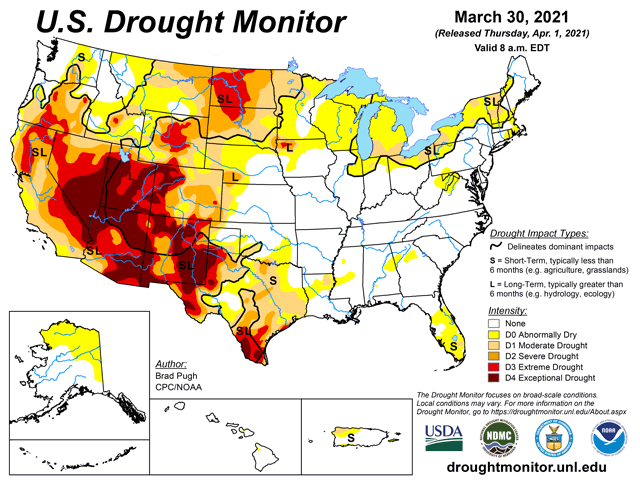Best Blog of the Week
Ag Weather Forum: Drier Start to 2021
The biggest item that popped out from the first USDA weekly Crop Progress report of the 2021 growing season was the soil moisture, or lack thereof.
Topsoil moisture rated adequate to surplus totals 65% this year, down 27 percentage points from a 92% adequate-to-surplus total last year. Subsoil moisture showed similar deficits, reporting 64% adequate to surplus as opposed to 91% last year. But it's not hard to understand why and this should not be surprising.
Going into the 2020 growing season, the country was coming off the wettest year on record in 2019. The Drought Monitor showed small sections of regional drought in south Texas, Florida, and through portions of the West. But a year ago, only 25.21% of the contiguous United States had some sort of dryness or drought; and, less than one-half percent (0.48%) of the country was rated as Extreme or Exceptional Drought (D3-D4).
P[L1] D[0x0] M[300x250] OOP[F] ADUNIT[] T[]
Contrast that with the current situation. 2020 ended up drier than normal for much of the country and drought grew through the year, including during the winter for many areas. According to the latest Drought Monitor on March 30, there are large swaths of Extreme and Exceptional Drought in the Southwest, west and south Texas, and the Dakotas; 63.41% of the contiguous U.S. is in some sort of dryness or drought, and 18.69% of the country is rated in Extreme or Exceptional Drought (D3-D4).
So, when the USDA's numbers came out on Monday, showing drastically different numbers as compared to a year ago, it does put some things into perspective going into this year.
In winter and spring 2020, we were worried about flooding and another slow start to the planting season. Of course, we know that did not pan out in a widespread fashion. La Nina was developing through the spring and summer and turned the wet start into a dry finish. Crop ratings and yield forecasts dropped through the summer as the dryness crept in.
This year is somewhat of a reversal. The La Nina did not do any favors to the nation's soil moisture across most of the country. Dryness starts out the year and moisture is needed in more areas than it was last year.
However, the weakening of La Nina toward a neutral state during the last couple of months has led to some better rainfall through March. Drought was at its worst in December when 67.40% of the contiguous U.S. was in some sort of dryness and drought. There has been some waffling during the winter, but dryness has been on a downtrend through March. Major reductions were noted recently in the Plains, where La Nina had spread its worst effects through the winter.
However, the dryness through the northern and western Plains and northern Midwest is more a concern, given the forecast. Last year, these areas were almost devoid of dryness and the developing drought saw worsening conditions through the year. A full soil moisture profile did allow for early growth. (There was also a notable occurrence of very wet ground which led to extensive prevented-planting acreage claims in North Dakota.) This year, crops do not have as much moisture to count on for early growth and will be dependent on more consistent precipitation for establishment. This is especially true across the northern and western tiers of the primary growing regions.
La Nina's weakening will bring up more uncertainty in the forecast, as sub-seasonal factors will influence the weather more than normal. Things like tropical thunderstorm clusters in the Indian and western Pacific Oceans, local soil moisture, and cloud cover will be bigger drivers of day-to-day and week-to-week weather. And, unfortunately, these things are harder to predict longer than a couple of weeks out. Therefore, forecasts you see, either from DTN or other sources, are likely to differ, change, and contain more uncertainty.
John Baranick can be reached at john.baranick@dtn.com
(c) Copyright 2021 DTN, LLC. All rights reserved.




